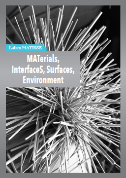Aller au contenu Aller au menu Aller à la recherche
 Navigation de la rubrique abonnements, dernières nouvellesPartenaires
Navigation de la rubrique abonnements, dernières nouvellesPartenaires
 accès rapides, services personnalisésTraductions :Labex MATISSE
accès rapides, services personnalisésTraductions :Labex MATISSE
Axe 4 - Dimensionnalité et confinement
AAP 2016 - Travail de recherche commencé le 1er novembre 2016
Soutenance de thèse le 5 novembre 2019 à 14h
Salle de conférence 401 - Couloir 22-23 - Campus Pierre et marie Curie
Niobium dioxide NbO2 has been recently gaining a lot of interest in the fields of solid-state physics and technological nano-devices. On one hand, NbO2 undergoes a structural distortion accompanied by an electronic phase transition where the material changes from an insulating state at room temperature into a metallic state at temperatures above ∼ 1080 K. On the other hand, NbO2 exhibits a negative differential resistance phase under the application of electric current, a phenomenon known as current-controlled negative differential resistance CC-NDR. These two characteristics in NbO2 promote it to be good candidate to develop many functional devices used for variety of applications such as electric switching and memory devices. However, despite the potentialities of NbO2, the understanding of this material is still incomplete as literature reporting many research work on NbO2 show contradictory or inconsistent information. One possible reason of this lack of consistency could emerge from the difficulty in the film fabrication of pure phase NbO2 and the different means in synthesizing them.
In this thesis, we have fabricated thin films of NbO2 by RF-mangentron sputtering technique on amorphous and crystalline substrates (glass and Si). The deposited films were always amorphous, and annealing treatment of the as-deposited films was necessary to achieve crystallinity. Annealing tests revealed that increasing both the annealing duration and the annealing temperature gives rise to better crystalline films. Optimized amorphous NbO2 films had a resistivity ρamo ∼ 5 Ω.cm while the crystalline films had a ρcry ∼ 50 Ω.cm both which are less than the bulk crystalline NbO2 ρbulk ∼ 104 Ω.cm. Upon performing electronic studies on NbO2, we witnessed CC-NDR with a hysteresis in the V(I) curves. We showed that hysteresis in CC-NDR is due to temperature inhomogeneity. Simultaneous electronic transport and Raman measurements show that CC-NDR is not associated to a phase transition (the phase is always insulating). Moreover, we showed that there is a similar temperature driven change in conductivity in both the amorphous and the crystalline samples, however, the amorphous sample is a better electronic and thermal conductor. Finally, we proved that the CC-NDR may be simply explained by the creation of carriers by temperature in a semiconductor, without the need for invoking more complicated transport mechanisms.
04/11/19
Traductions :
» En savoir plus sur «la plaquette de présentation du LabEx MATISSE (version anglaise)»
Direction
Florence Babonneau
Administration
matisse @ upmc.fr (matisse @ upmc.fr)
Communication
Emmanuel Sautjeau
emmanuel.sautjeau @ sorbonne-universite.fr (emmanuel.sautjeau @ sorbonne-universite.fr)
UPMC